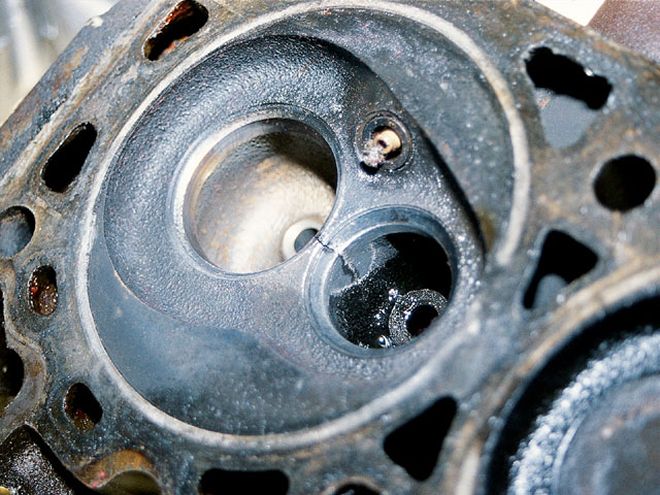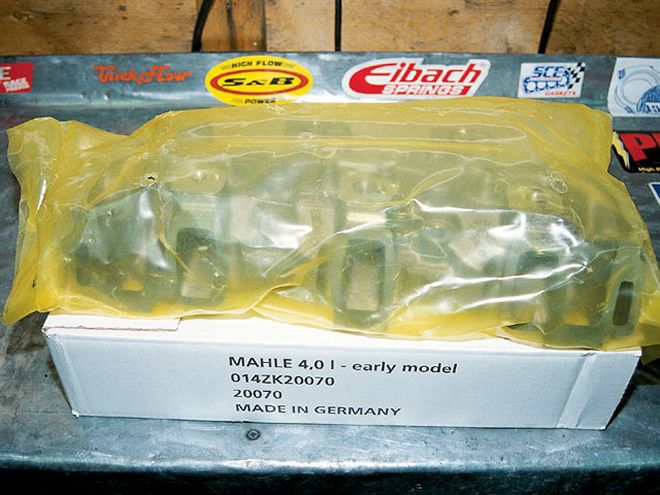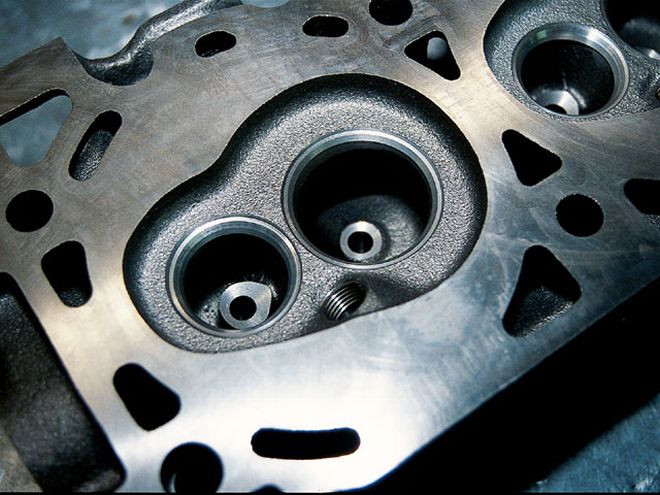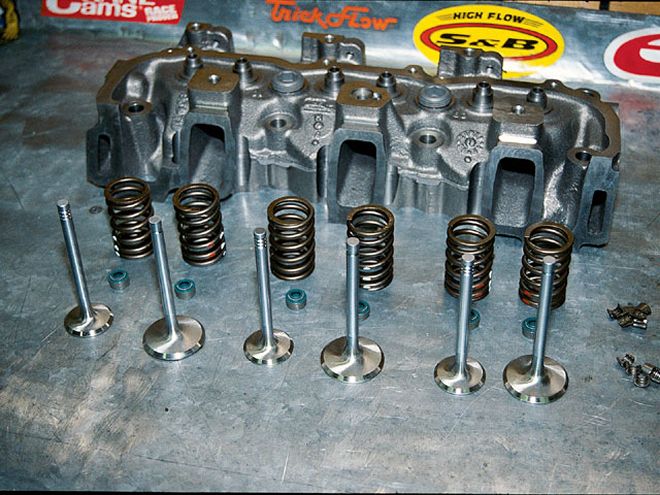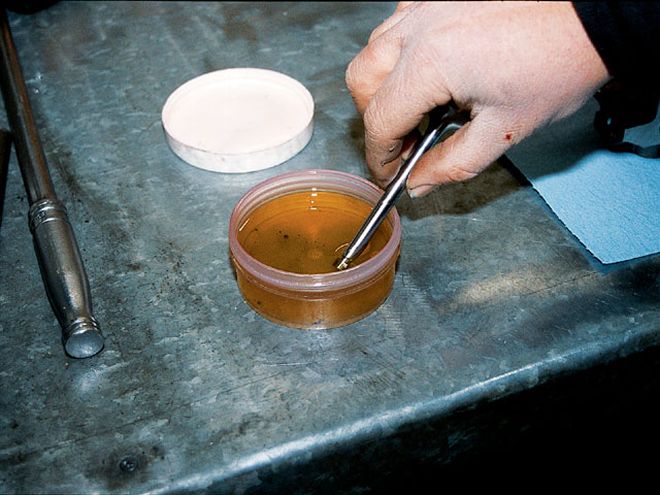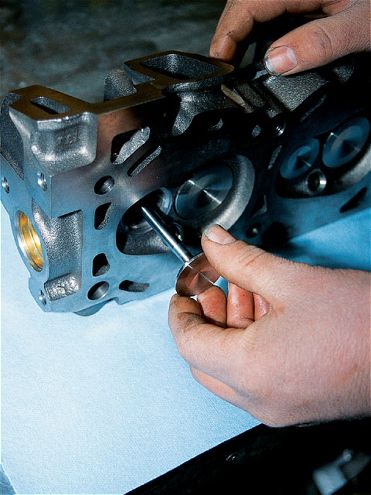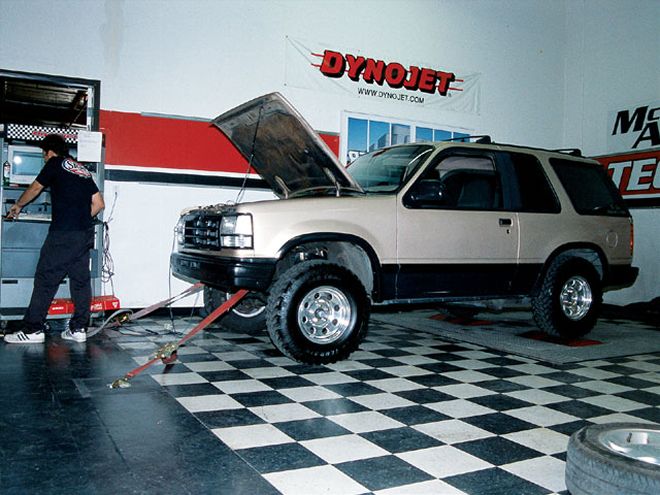
| tuning Tricks ford Explorer
In the early '90s, Ford debuted the all-new Ford Explorer outfitted with the 4.0L V-6. Needless to say, with millions sold over the years, the Explorer has gone on to be one of Ford's biggest success stories. The 4.0L powerplant has its roots in Europe, where it is known as the Cologne engine. Since it has a reputation as being reliable and making good torque, it eventually was offered in the Ford Ranger beginning in the early '90s and was used through the '00 model year. Today's 4.0L powerplant, also found in the Explorer and Ranger, uses the pushrod motor's bottom end, but now sports a new set of overhead cam cylinder heads.
The bottom line is there are thousands and thousands of these powerplants out there in both Explorers and Rangers that are getting up there in age and mileage and are do for a makeover. The good news is that both trucks can be had rather cheaply these days on the used market, and can be made into a killer sport truck or off-road vehicle with a minimal amount of money.
The biggest complaint, however, as is the case for most trucks owners, is a lack of power. There are several bolt-on power parts available for the 4.0L V-6 that bring the engine alive and push it into V-8 territory in terms of power. Several manufacturers offer simple upgrades, such as after-cat exhaust systems and air intakes, while others offer a more extensive product line for the six-cylinder powerplant.
One company, with a long lineage of 4.0L performance history, offers the "good stuff," such as larger mass airflow meters, headers, roller rockers, camshafts, valve springs, pushrods, throttle-body upgrades, and more. 4.0-Liter Performance of Tehachapi, California, has been tweaking Rangers and Explorers for more than 10 years and knows what it takes to squeeze the most out of Ford's premier V-6. One of the company's test mules outfitted with a 4.0L V-6 was clocked at the Silver State Classic Open Road Race at 147 mph and made nearly 280 rear-wheel horsepower on the dyno.
To illustrate how easy it is to find one of these trucks and modify it, we found a well-worn '92 Explorer Sport for sale that had apparently blown a head gasket after an overheating session. Upon further inspection, we found a rather large crack between the intake and exhaust valve that feeds the number three cylinder. We started collecting information to figure out what our options were at this point, other than to stuff a 5.0L V-8 in it, and quickly learned that there were few rebuilt 4.0L heads available on exchange. Apparently, these heads are so prone to cracks and warpage, that there are only a few rebuildable cores available. This problem, coupled with exhaust manifolds that are also prone to cracks, makes used parts hard to find.
For this particular truck, the initial plan was to go with a handful of popular bolt-ons, such as an upgraded exhaust and intake. The first step was to put the truck on the dyno for baseline numbers. In stock trim, even with 31-inch all-terrain tires on the truck, the Explorer managed to make approximately 120 rear-wheel horsepower and 181 lb-ft of torque.
Our list of bolt-ons included a larger mass airflow sensor and air intake from 4.0-Liter Performance, a Flowmaster Force II after-cat exhaust system, and a piggyback-style performance module from Hypertech. We knew these three common upgrades would help significantly, but only with a solid motor to start with.
Now faced with bad cylinder heads, we turned to Mahle Motorsports, who is a supplier of new head castings for the 4.0L V-6 motors. Besides being brand new and ready to build, the cool thing about the Mahle heads is that they're 4 pounds heavier per head than the originals. Those extra 4 pounds of cast iron are in all the right places, making the heads virtually bulletproof compared with the stockers. Of course the hot ticket would have been to do a little porting on the stockers for some addition flow, but since we were on a budget, the heads remained as they came.
With the new heads in possession, we got back in touch with Dennis Hilliard of 4.0-Liter Performance, (a division of Central Coast Motorsports) and he supplied us with the company's trick tapered-stem stainless valves and high-performance valvesprings. He even offered to have his in-house engine building team, Boss Motorsports, assemble the heads for us. Many long-time Sport Truck readers might recognize 4.0-Liter Performance and Dennis Hilliard's name. He and Editor Kevin Wilson set a record in a '91 Ford Ranger powered by a supercharged 4.0L V-6 in the Silver State Classic Open Road Race during the mid '90s.
With the cylinder heads ready to bolt on, we still felt there was one element missing from the power mix - headers - so we turned to JBA for a set of the company's smog-legal shorty headers. JBA even supplied us with its performance plug wires to round out the buildup perfectly. Once the motor was complete, the addition of the power parts was a simple bolt-on affair.
Once the Explorer was back on the street, and we put a few miles on it for the computer to recognize our bolt-on modifications, we motored back to the tech center for some final numbers. On the dyno, the Explorer registered 145 rear-wheel horsepower at 4,400 rpm and 210 lb-ft of torque at approximately 4,000 rpm. That's a solid increase of 25 rear-wheel horsepower and 29 lb-ft of torque - and that's with simple bolt-ons. Hilliard told us these are very repeatable numbers on most 4.0L V-6s (providing the engine is sound to begin with) and that an upgraded throttle body, some roller rockers, and even a camshaft would boost the power levels even higher.
Best of all, the increase in power is noticeable in improved driveability. Off-the-line torque and throttle response are up considerably. If you own an early model Ranger or Explorer with the 4.0L V-6 and are searching for more power, check into these easy upgrades for instant gratification.
 | tuning Tricks ford Explorer
In the early '90s, Ford debuted the all-new Ford Explorer outfitted with the 4.0L V-6. Needless to say, with millions sold over the years, the Explorer has gone on to be one of Ford's biggest success stories. The 4.0L powerplant has its roots in Europe, where it is known as the Cologne engine. Since it has a reputation as being reliable and making good torque, it eventually was offered in the Ford Ranger beginning in the early '90s and was used through the '00 model year. Today's 4.0L powerplant, also found in the Explorer and Ranger, uses the pushrod motor's bottom end, but now sports a new set of overhead cam cylinder heads.
The bottom line is there are thousands and thousands of these powerplants out there in both Explorers and Rangers that are getting up there in age and mileage and are do for a makeover. The good news is that both trucks can be had rather cheaply these days on the used market, and can be made into a killer sport truck or off-road vehicle with a minimal amount of money.
The biggest complaint, however, as is the case for most trucks owners, is a lack of power. There are several bolt-on power parts available for the 4.0L V-6 that bring the engine alive and push it into V-8 territory in terms of power. Several manufacturers offer simple upgrades, such as after-cat exhaust systems and air intakes, while others offer a more extensive product line for the six-cylinder powerplant.
One company, with a long lineage of 4.0L performance history, offers the "good stuff," such as larger mass airflow meters, headers, roller rockers, camshafts, valve springs, pushrods, throttle-body upgrades, and more. 4.0-Liter Performance of Tehachapi, California, has been tweaking Rangers and Explorers for more than 10 years and knows what it takes to squeeze the most out of Ford's premier V-6. One of the company's test mules outfitted with a 4.0L V-6 was clocked at the Silver State Classic Open Road Race at 147 mph and made nearly 280 rear-wheel horsepower on the dyno.
To illustrate how easy it is to find one of these trucks and modify it, we found a well-worn '92 Explorer Sport for sale that had apparently blown a head gasket after an overheating session. Upon further inspection, we found a rather large crack between the intake and exhaust valve that feeds the number three cylinder. We started collecting information to figure out what our options were at this point, other than to stuff a 5.0L V-8 in it, and quickly learned that there were few rebuilt 4.0L heads available on exchange. Apparently, these heads are so prone to cracks and warpage, that there are only a few rebuildable cores available. This problem, coupled with exhaust manifolds that are also prone to cracks, makes used parts hard to find.
For this particular truck, the initial plan was to go with a handful of popular bolt-ons, such as an upgraded exhaust and intake. The first step was to put the truck on the dyno for baseline numbers. In stock trim, even with 31-inch all-terrain tires on the truck, the Explorer managed to make approximately 120 rear-wheel horsepower and 181 lb-ft of torque.
Our list of bolt-ons included a larger mass airflow sensor and air intake from 4.0-Liter Performance, a Flowmaster Force II after-cat exhaust system, and a piggyback-style performance module from Hypertech. We knew these three common upgrades would help significantly, but only with a solid motor to start with.
Now faced with bad cylinder heads, we turned to Mahle Motorsports, who is a supplier of new head castings for the 4.0L V-6 motors. Besides being brand new and ready to build, the cool thing about the Mahle heads is that they're 4 pounds heavier per head than the originals. Those extra 4 pounds of cast iron are in all the right places, making the heads virtually bulletproof compared with the stockers. Of course the hot ticket would have been to do a little porting on the stockers for some addition flow, but since we were on a budget, the heads remained as they came.
With the new heads in possession, we got back in touch with Dennis Hilliard of 4.0-Liter Performance, (a division of Central Coast Motorsports) and he supplied us with the company's trick tapered-stem stainless valves and high-performance valvesprings. He even offered to have his in-house engine building team, Boss Motorsports, assemble the heads for us. Many long-time Sport Truck readers might recognize 4.0-Liter Performance and Dennis Hilliard's name. He and Editor Kevin Wilson set a record in a '91 Ford Ranger powered by a supercharged 4.0L V-6 in the Silver State Classic Open Road Race during the mid '90s.
With the cylinder heads ready to bolt on, we still felt there was one element missing from the power mix - headers - so we turned to JBA for a set of the company's smog-legal shorty headers. JBA even supplied us with its performance plug wires to round out the buildup perfectly. Once the motor was complete, the addition of the power parts was a simple bolt-on affair.
Once the Explorer was back on the street, and we put a few miles on it for the computer to recognize our bolt-on modifications, we motored back to the tech center for some final numbers. On the dyno, the Explorer registered 145 rear-wheel horsepower at 4,400 rpm and 210 lb-ft of torque at approximately 4,000 rpm. That's a solid increase of 25 rear-wheel horsepower and 29 lb-ft of torque - and that's with simple bolt-ons. Hilliard told us these are very repeatable numbers on most 4.0L V-6s (providing the engine is sound to begin with) and that an upgraded throttle body, some roller rockers, and even a camshaft would boost the power levels even higher.
Best of all, the increase in power is noticeable in improved driveability. Off-the-line torque and throttle response are up considerably. If you own an early model Ranger or Explorer with the 4.0L V-6 and are searching for more power, check into these easy upgrades for instant gratification.
| tuning Tricks ford Explorer
In the early '90s, Ford debuted the all-new Ford Explorer outfitted with the 4.0L V-6. Needless to say, with millions sold over the years, the Explorer has gone on to be one of Ford's biggest success stories. The 4.0L powerplant has its roots in Europe, where it is known as the Cologne engine. Since it has a reputation as being reliable and making good torque, it eventually was offered in the Ford Ranger beginning in the early '90s and was used through the '00 model year. Today's 4.0L powerplant, also found in the Explorer and Ranger, uses the pushrod motor's bottom end, but now sports a new set of overhead cam cylinder heads.
The bottom line is there are thousands and thousands of these powerplants out there in both Explorers and Rangers that are getting up there in age and mileage and are do for a makeover. The good news is that both trucks can be had rather cheaply these days on the used market, and can be made into a killer sport truck or off-road vehicle with a minimal amount of money.
The biggest complaint, however, as is the case for most trucks owners, is a lack of power. There are several bolt-on power parts available for the 4.0L V-6 that bring the engine alive and push it into V-8 territory in terms of power. Several manufacturers offer simple upgrades, such as after-cat exhaust systems and air intakes, while others offer a more extensive product line for the six-cylinder powerplant.
One company, with a long lineage of 4.0L performance history, offers the "good stuff," such as larger mass airflow meters, headers, roller rockers, camshafts, valve springs, pushrods, throttle-body upgrades, and more. 4.0-Liter Performance of Tehachapi, California, has been tweaking Rangers and Explorers for more than 10 years and knows what it takes to squeeze the most out of Ford's premier V-6. One of the company's test mules outfitted with a 4.0L V-6 was clocked at the Silver State Classic Open Road Race at 147 mph and made nearly 280 rear-wheel horsepower on the dyno.
To illustrate how easy it is to find one of these trucks and modify it, we found a well-worn '92 Explorer Sport for sale that had apparently blown a head gasket after an overheating session. Upon further inspection, we found a rather large crack between the intake and exhaust valve that feeds the number three cylinder. We started collecting information to figure out what our options were at this point, other than to stuff a 5.0L V-8 in it, and quickly learned that there were few rebuilt 4.0L heads available on exchange. Apparently, these heads are so prone to cracks and warpage, that there are only a few rebuildable cores available. This problem, coupled with exhaust manifolds that are also prone to cracks, makes used parts hard to find.
For this particular truck, the initial plan was to go with a handful of popular bolt-ons, such as an upgraded exhaust and intake. The first step was to put the truck on the dyno for baseline numbers. In stock trim, even with 31-inch all-terrain tires on the truck, the Explorer managed to make approximately 120 rear-wheel horsepower and 181 lb-ft of torque.
Our list of bolt-ons included a larger mass airflow sensor and air intake from 4.0-Liter Performance, a Flowmaster Force II after-cat exhaust system, and a piggyback-style performance module from Hypertech. We knew these three common upgrades would help significantly, but only with a solid motor to start with.
Now faced with bad cylinder heads, we turned to Mahle Motorsports, who is a supplier of new head castings for the 4.0L V-6 motors. Besides being brand new and ready to build, the cool thing about the Mahle heads is that they're 4 pounds heavier per head than the originals. Those extra 4 pounds of cast iron are in all the right places, making the heads virtually bulletproof compared with the stockers. Of course the hot ticket would have been to do a little porting on the stockers for some addition flow, but since we were on a budget, the heads remained as they came.
With the new heads in possession, we got back in touch with Dennis Hilliard of 4.0-Liter Performance, (a division of Central Coast Motorsports) and he supplied us with the company's trick tapered-stem stainless valves and high-performance valvesprings. He even offered to have his in-house engine building team, Boss Motorsports, assemble the heads for us. Many long-time Sport Truck readers might recognize 4.0-Liter Performance and Dennis Hilliard's name. He and Editor Kevin Wilson set a record in a '91 Ford Ranger powered by a supercharged 4.0L V-6 in the Silver State Classic Open Road Race during the mid '90s.
With the cylinder heads ready to bolt on, we still felt there was one element missing from the power mix - headers - so we turned to JBA for a set of the company's smog-legal shorty headers. JBA even supplied us with its performance plug wires to round out the buildup perfectly. Once the motor was complete, the addition of the power parts was a simple bolt-on affair.
Once the Explorer was back on the street, and we put a few miles on it for the computer to recognize our bolt-on modifications, we motored back to the tech center for some final numbers. On the dyno, the Explorer registered 145 rear-wheel horsepower at 4,400 rpm and 210 lb-ft of torque at approximately 4,000 rpm. That's a solid increase of 25 rear-wheel horsepower and 29 lb-ft of torque - and that's with simple bolt-ons. Hilliard told us these are very repeatable numbers on most 4.0L V-6s (providing the engine is sound to begin with) and that an upgraded throttle body, some roller rockers, and even a camshaft would boost the power levels even higher.
Best of all, the increase in power is noticeable in improved driveability. Off-the-line torque and throttle response are up considerably. If you own an early model Ranger or Explorer with the 4.0L V-6 and are searching for more power, check into these easy upgrades for instant gratification.
